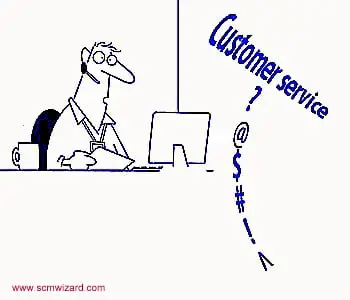Customer service is a set of activities and programs designed and implemented by a business firm to make the buying experience more rewarding. These activities enhance the value of a product or service the customer gets from the seller. Customer perception of service quality is the most important dimension of product/service offerings to the customer.
Value-added customer service is leveraged to gain competitive advantage. Good customer perception builds customer loyalty among the existing customers and generates positive word-of-mouth communication, which attracts new customers. In other words, customer service is the base for all customer relationship management (CRM) programs that may leading firms are implementing.
Read also: Pre Transaction Phase in Customer Service
Customers base their evaluation of a service on their perceptions. These perceptions are affected by the actual service provided by the firm and the high degree of intangibility, which is sometimes very hard to accurately evaluate.
Firms that are able to map these gaps accurately and try to bridge them with value-added service can succeed in enhancing the customer satisfaction level and remain competitive. The following are a few cues affecting customer perception of service quality:
Read also: Transaction phase in Customer Service
- Competence: the information provided by the firm through product brochures, manuals, websites, sales talk about the product and the service offerings of the firm.
- Reliability: delivery of the product or services as promised regarding place, time and quality.
- Responsiveness: returning customer calls, e-mails, faxes, letters, and so forth on time and resolving customer problems or complaints with speed during all three phases of a transaction.
- Transaction security: the confidentiality of customer information and transactions.
- Trustworthiness: built through evolving policies on product return, warranty and guarantee, and honoring commitments.
- Access: this refers to the ease with which the customer will have access to information on products and services before placing an order, status of the order placed, and status of the product complaints, claims and damages in the post-sales phase.
- Communication: the actual service provided may be different from what is communicated through a promotional or advertising campaign.
- Standards adopted: the service standards adopted may differ from the customer’s expectations.
- Service delivery: the services provided may be different from the service standards of the firm.
- Customer knowledge: the firm may fail to understand the customer’s perception of the service standard.
Logistics is a service function and has a large share in an organization’s success by delivering the product at the right place and at the right time. In logistics, the customer is a place where the goods or services are delivered. For physical products, it may be a manufacturing plant, wholesales, retailer, or end-user.
For the service products it may be the point of sale of a service with as a hotel, bank or hospital. However, the focus here is customer service, irrespective of the ways, means, and methods being used to satisfy the customer. This approach requires marketing orientation to all the functional areas of the organization. Marketing is the central point of all business process.
The objective of the marketing function is to identify the need of the customers and fulfill it at a price by generating profitable transactions. Logistics helps in creating time and place utility of the product that satisfies the customers’ need, which has both time and place as dimensions.
Read also: Functions of Logistics
In today’s competitive markets, the competitiveness of a firm is judged by how efficiently and effectively it manages the time and place dimensions of customer service to avail of the opportunity and create new opportunities for repeat sales to the same customer perception by delivering superior service.
Hence, logistics competency is critical to customer service planning with perception and needs to be developed as a core competency for the sustainable competitive advantage not only for growth both also for survival.





